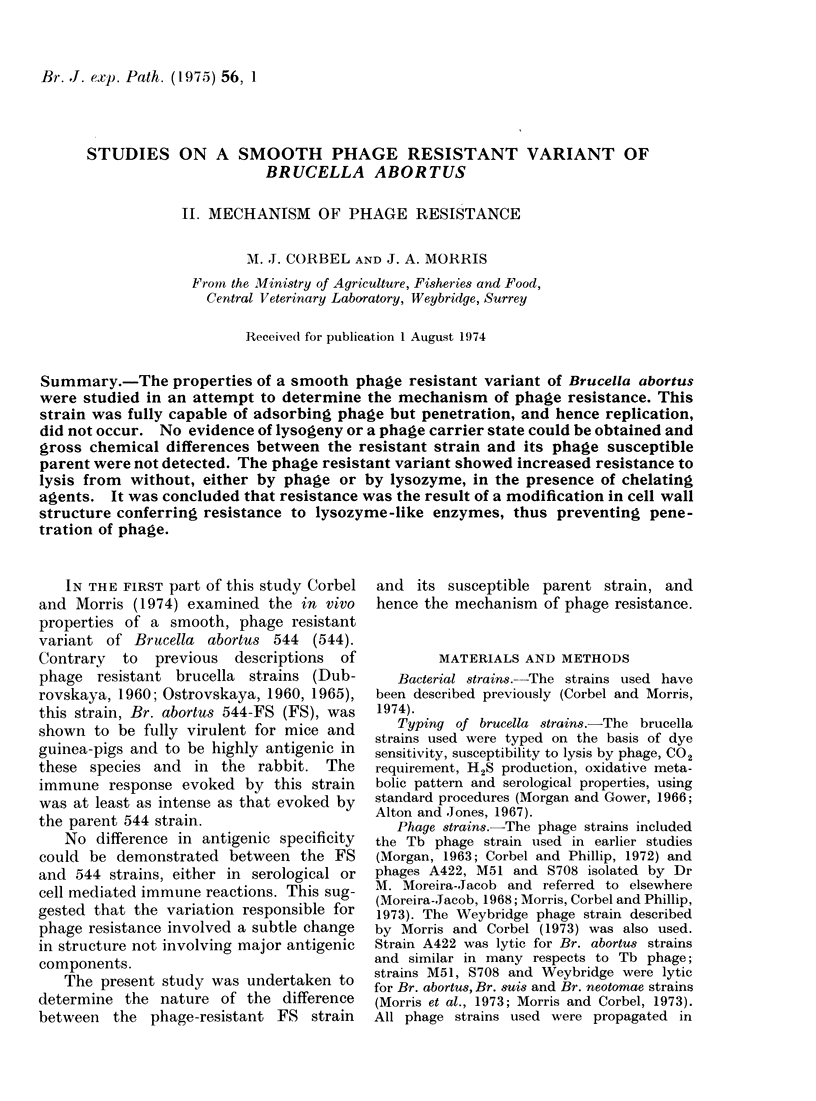Studies on a smooth phage resistant variant of Brucella abortus II. Mechanism of phage resistance (original) (raw)
Abstract
The properties of a smooth phage resistant variant of Brucella abortus were studied in an attempt to determine the mechanism of phage resistance. This strain was fully capable of adsorbing phage but penetration, and hence replication, did not occur. No evidence of lysogeny or a phage carrier state could be obtained and gross chemical differences between the resistant strain and its phage susceptible parent were not detected. The phage resistant variant showed increased resistance to lysis from without, either by phage or by lysozyme, in the presence of chelating agents. It was concluded that resistance was the result of a modification in cell wall structure conferring resistance to lysozyme-like enzymes, thus preventing penetration of phage.

Images in this article
Selected References
These references are in PubMed. This may not be the complete list of references from this article.
- ALTENBERN R. A., STULL H. B. INDUCIBLE LYTIC SYSTEMS IN THE GENUS BACILLUS. J Gen Microbiol. 1965 Apr;39:53–62. doi: 10.1099/00221287-39-1-53. [DOI] [PubMed] [Google Scholar]
- Bradley D. E. Ultrastructure of bacteriophage and bacteriocins. Bacteriol Rev. 1967 Dec;31(4):230–314. doi: 10.1128/br.31.4.230-314.1967. [DOI] [PMC free article] [PubMed] [Google Scholar]
- Corbel M. J., Morris J. A. Studies on a smooth phage-resistant variant of Brucella abortus. I. Immunological properties. Br J Exp Pathol. 1974 Feb;55(1):78–87. [PMC free article] [PubMed] [Google Scholar]
- FREDERICQ P. Colicins. Annu Rev Microbiol. 1957;11:7–22. doi: 10.1146/annurev.mi.11.100157.000255. [DOI] [PubMed] [Google Scholar]
- JONES L. M., McDUFF C. R., WILSON J. B. Phenotypic alterations in the colonial morphology of Brucella abortus due to a bacteriophage carrier state. J Bacteriol. 1962 Apr;83:860–866. doi: 10.1128/jb.83.4.860-866.1962. [DOI] [PMC free article] [PubMed] [Google Scholar]
- Jones L. M., Merz G. S., Wilson J. B. A lytic factor associated with brucellaphage causing "lysis-from-without". Experientia. 1968 Jan 15;24(1):20–22. doi: 10.1007/BF02136766. [DOI] [PubMed] [Google Scholar]
- LOWRY O. H., ROSEBROUGH N. J., FARR A. L., RANDALL R. J. Protein measurement with the Folin phenol reagent. J Biol Chem. 1951 Nov;193(1):265–275. [PubMed] [Google Scholar]
- MASTER R. W. POSSIBLE SYNTHESIS OF POLYRIBONUCLEOTIDES OF KNOWN BASE-TRIPLET SEQUENCES. Nature. 1965 Apr 3;206:93–93. doi: 10.1038/206093b0. [DOI] [PubMed] [Google Scholar]
- Moreira-Jacob M. New group of virulent bacteriophages showing differential affinity for Brucella species. Nature. 1968 Aug 17;219(5155):752–753. doi: 10.1038/219752a0. [DOI] [PubMed] [Google Scholar]
- Morris J. A., Corbel M. J., Phillip J. I. Characterization of three phages lytic for Brucella species. J Gen Virol. 1973 Jul;20(1):63–73. doi: 10.1099/0022-1317-20-1-63. [DOI] [PubMed] [Google Scholar]
- Morris J. A., Corbel M. J. Properties of a new phage lytic for Brucella suis. J Gen Virol. 1973 Dec;21(3):539–544. doi: 10.1099/0022-1317-21-3-539. [DOI] [PubMed] [Google Scholar]